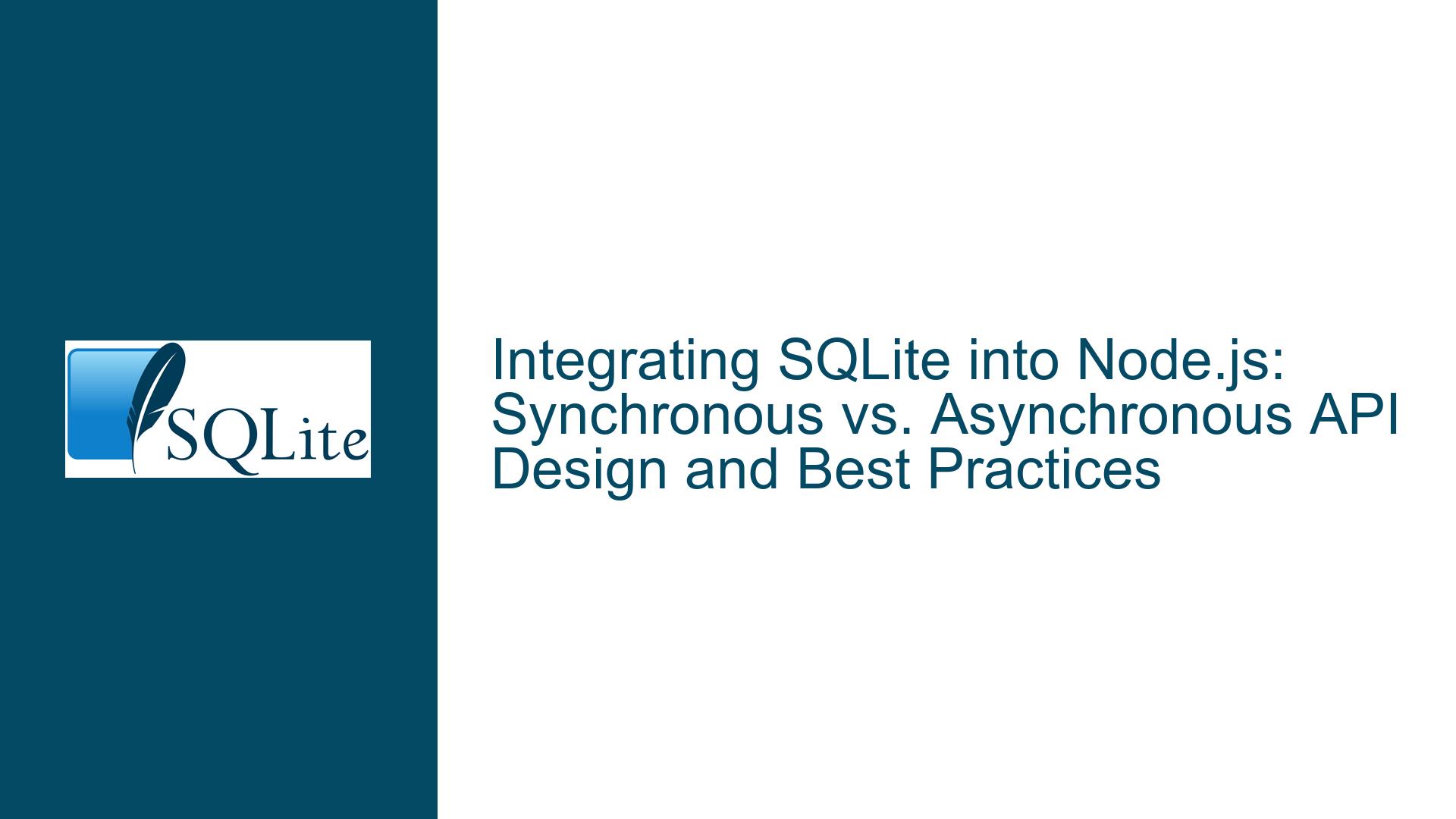Integrating SQLite into Node.js: Synchronous vs. Asynchronous API Design and Best Practices
Synchronous vs. Asynchronous SQLite API Integration in Node.js
The integration of SQLite into Node.js presents a unique challenge due to the inherent differences in execution models between the two systems. SQLite is a synchronous, single-threaded, in-process database engine, while Node.js is built on a non-blocking, event-driven architecture designed for high concurrency and scalability. This fundamental mismatch raises critical questions about how to design an API that bridges these two paradigms effectively. The core issue revolves around whether to expose a synchronous API, an asynchronous API, or both, and how to align these choices with the performance characteristics and user expectations of both SQLite and Node.js.
Trade-offs Between Synchronous and Asynchronous Execution Models
The debate between synchronous and asynchronous APIs for SQLite in Node.js hinges on the trade-offs between simplicity, performance, and idiomatic usage. SQLite’s synchronous nature means that all database operations block the calling thread until completion. This design is intentional, as SQLite prioritizes data integrity and simplicity over concurrency. However, Node.js thrives on non-blocking I/O, using mechanisms like epoll, io_uring, and iocp to handle thousands of concurrent connections efficiently. Introducing a synchronous API into Node.js risks undermining its core strengths, as blocking operations can stall the event loop and degrade performance.
On the other hand, an asynchronous API would allow Node.js applications to perform other tasks while waiting for SQLite operations to complete. This approach aligns with Node.js’s non-blocking philosophy but introduces complexity. SQLite’s synchronous design does not natively support asynchronous operations, meaning any asynchronous API would need to rely on workarounds such as threading or queuing. These workarounds can introduce overhead, increase latency, and complicate error handling. Additionally, forcing SQLite into an asynchronous model may obscure its simplicity and predictability, which are key reasons developers choose SQLite in the first place.
The choice between synchronous and asynchronous APIs also has implications for developer experience. A synchronous API, like the one provided by better-sqlite3, is straightforward and easy to use but may feel out of place in a Node.js environment. An asynchronous API, like node-sqlite3, feels more idiomatic but can lead to verbose code filled with await statements, negating some of the benefits of non-blocking I/O. Furthermore, the lack of a native asynchronous mode in SQLite means that any asynchronous API would be a layer of abstraction over the synchronous core, potentially hiding low-level features and limiting flexibility.
Building a Robust SQLite Integration for Node.js
To address these challenges, a robust SQLite integration for Node.js should consider a layered approach that provides both synchronous and asynchronous APIs while maintaining access to SQLite’s full feature set. This approach involves creating a low-level "non-wrapper" binding that closely mirrors the SQLite C API, followed by higher-level wrappers that offer synchronous and asynchronous interfaces tailored to different use cases.
The low-level binding would serve as the foundation, exposing SQLite’s capabilities with minimal abstraction. This binding would be intentionally non-idiomatic, prioritizing completeness and flexibility over ease of use. While this approach may not appeal to the majority of Node.js developers, it would empower library authors and advanced users to build custom solutions on top of the binding. For example, a library author could use the low-level binding to create a high-level wrapper that integrates seamlessly with Node.js’s event loop and provides an idiomatic API.
On top of the low-level binding, two higher-level wrappers could be developed: one synchronous and one asynchronous. The synchronous wrapper would provide a simple, blocking API for use cases where performance is not critical or where the simplicity of synchronous code is preferred. The asynchronous wrapper would leverage Node.js’s thread pool to offload SQLite operations, allowing the event loop to remain unblocked. This wrapper would use promises or callbacks to provide a non-blocking interface, making it suitable for high-concurrency applications.
This layered approach offers several advantages. First, it ensures that all users, regardless of their needs, have access to SQLite’s full feature set. Second, it allows developers to choose the API that best fits their use case, whether they prioritize simplicity, performance, or idiomatic usage. Third, it future-proofs the integration by providing a solid foundation for future wrappers and adaptations as the Node.js ecosystem evolves.
In addition to the layered architecture, the integration should include robust error handling, comprehensive documentation, and performance optimizations. Error handling should be consistent across both synchronous and asynchronous APIs, with clear guidance on how to handle common issues like database locks and I/O errors. Documentation should explain the trade-offs between the different APIs and provide examples of best practices for each. Performance optimizations should focus on minimizing the overhead of the asynchronous wrapper, ensuring that it does not introduce unnecessary latency or resource usage.
By adopting this approach, the Node.js project can provide a SQLite integration that is both powerful and flexible, meeting the needs of a wide range of developers while staying true to the strengths of both SQLite and Node.js. This solution would not replace existing libraries like better-sqlite3 and node-sqlite3 but would instead complement them, offering a built-in option for developers who prefer to use native Node.js modules.
Practical Steps for Implementing and Debugging SQLite in Node.js
Implementing a SQLite integration in Node.js requires careful planning and attention to detail. The following steps outline a practical approach to building, testing, and debugging the integration:
Develop the Low-Level Binding: Start by creating a low-level binding that exposes the SQLite C API to Node.js. This binding should use Node.js’s N-API or a similar mechanism to interface with native code. Focus on completeness and accuracy, ensuring that all SQLite functions and features are accessible. Test the binding thoroughly to verify that it behaves as expected and handles edge cases correctly.
Design the Synchronous Wrapper: Build a synchronous wrapper on top of the low-level binding. This wrapper should provide a simple, blocking API that mirrors the functionality of libraries like
better-sqlite3. Pay attention to performance, as even synchronous APIs can benefit from optimizations like prepared statement caching and connection pooling. Document the API clearly, emphasizing its simplicity and suitability for specific use cases.Implement the Asynchronous Wrapper: Create an asynchronous wrapper that uses Node.js’s thread pool to offload SQLite operations. This wrapper should use promises or callbacks to provide a non-blocking interface. Be mindful of the overhead introduced by threading and queuing, and optimize the wrapper to minimize latency and resource usage. Test the wrapper under heavy load to ensure that it performs well in high-concurrency scenarios.
Integrate with Node.js Core: Work with the Node.js core team to integrate the SQLite bindings into the Node.js runtime. This step may involve discussions about API design, performance considerations, and long-term maintenance. Ensure that the integration aligns with Node.js’s goals and standards, and provide clear documentation for users and contributors.
Test and Debug: Test the integration extensively, covering all aspects of functionality, performance, and error handling. Use automated tests to verify that the bindings and wrappers work correctly under various conditions. Debug any issues that arise, paying special attention to edge cases and performance bottlenecks. Gather feedback from users and incorporate their suggestions into the implementation.
Document and Educate: Provide comprehensive documentation for the SQLite integration, including tutorials, API references, and best practices. Educate users about the trade-offs between the synchronous and asynchronous APIs, and guide them in choosing the right approach for their needs. Consider creating sample applications and case studies to demonstrate the integration in action.
By following these steps, the Node.js project can deliver a SQLite integration that meets the needs of developers while maintaining the performance and flexibility that make both SQLite and Node.js popular choices for modern applications. This integration would not only enhance the Node.js ecosystem but also set a standard for how to bridge synchronous and asynchronous execution models effectively.






